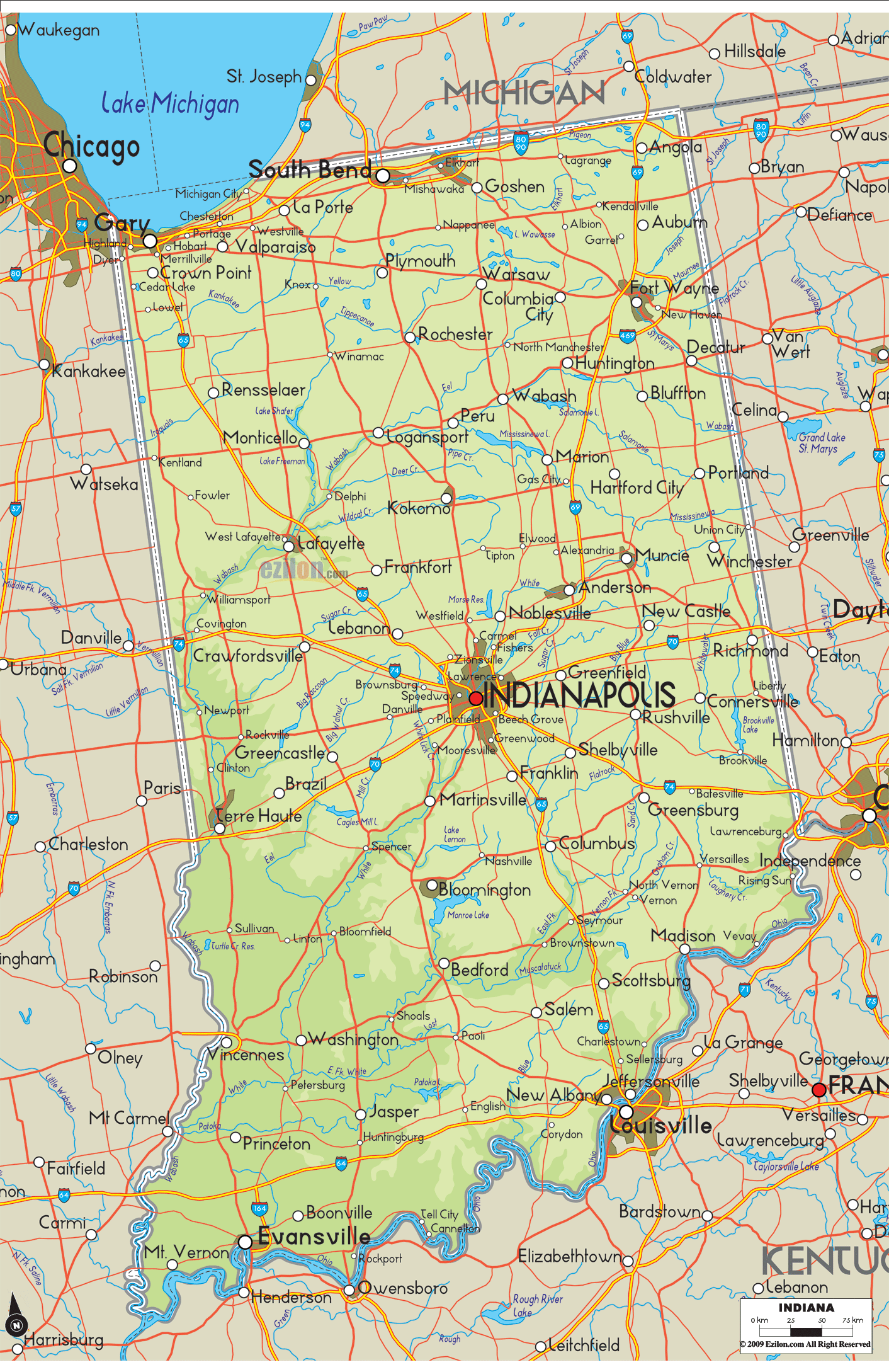

Description: The Physical map of Indiana State, USA showing major geographical features such as rivers, lakes, topography, vegetations and land formations.

Welcome to a meticulous and multi-faceted platform offering an in-depth, extensive, detailed physical map of Indiana. It is not just another map but a comprehensive resource designed to shed light on Indiana's diverse topographical features, including its rivers, lakes, mountains, hills, and various land formations.
The guide divides itself into specific geographical sections covering Indiana's South, North, East, West, and Central regions. It aims to provide an exhaustive understanding to students, teachers, nature explorers, and anyone intrigued by Indiana's geographical features. By finishing this article, you will have virtually crisscrossed Indiana, understanding the delicate nuances contributing to its physical identity.
Southern Indiana is not just geologically fascinating; it's a testament to natural forces' raw power and artistry. Dominated by limestone karsts—unique formations that offer a glimpse into ancient geological processes—this region is part of the Indiana Uplands. These uplands are a collection of rolling hills and elevations that provide a dramatic counterpoint to Indiana's otherwise relatively flat profile.
The Hoosier National Forest spans a significant portion of this area, offering an intricate mosaic of flora and fauna. But what stands out the most is the Ohio River, a magnificent waterway that carves out the state's southern boundary.
It is not merely a river but a living, breathing ecosystem that supports diverse wildlife and serves multiple human needs. Its tributaries, such as the Blue River, Patoka River, and Muscatatuck River, play crucial roles in draining the area and enriching its ecology.
If the South is about limestone and rivers, the North is about water and sand. Located primarily within the Great Lakes Lowland, Northern Indiana is a treasure trove of glacially-formed features. The Indiana Dunes—a State Park and a National Park - are perhaps the most iconic.
These aren't mere piles of sand; they're complex, evolving ecosystems that harbor some of the state's rarest plant species. The Lake Michigan shoreline offers more than a picturesque sunset; it's an essential migratory route for various bird species. While the dunes get much attention, let's not overlook the region's glacial kettle lakes - Lake Maxinkuckee, Lake Wawasee, and Lake James—each with its unique origin story and ecosystem, offering various recreational activities from sailing to bird-watching.
Eastern Indiana may initially appear as an endless expanse of agricultural fields, but beneath this seeming monotony lies a land of complex geological history. This area predominantly consists of the Till Plain, a flat but fertile stretch that owes its richness to glacial deposits. The White River serves as the primary hydrological feature.
More than just a river, it's a lifeline that irrigates vast land and supports a rich aquatic ecosystem. The Flatrock and Big Blue Rivers are key tributaries whose confluence areas serve as ecological hotspots. Despite its predominantly flat terrain, the site includes isolated hillocks and valleys that add a third dimension to its landscape, such as Hoosier Hill, the state's highest natural point.
In Western Indiana, water and land unite in a symphony of natural beauty. The show's star here is the Wabash River, Indiana's official river. This river doesn't just mark a boundary with Illinois; it's the beating heart of Western Indiana's geographical identity. Its floodplains, including Beaver Marsh, serve as ecological sanctuaries for diverse wildlife like beavers, herons, and ducks.
The Tippecanoe and Vermilion rivers, its primary tributaries, bring in their character, not just adding water but enriching the land with minerals and fostering unique aquatic habitats. It's not all water, though. The region also includes the Grand Prairie, a once expansive grassland that has now mostly made way for agriculture but still exists in pockets as a reminder of the past.
Central Indiana, the geographical and administrative core of the state, brings together elements from all around it, offering a miniaturized but intricate representation of Indiana's broader landscape. The region is primarily a till plain, but various geographical features like minor hills, dales, and depressions punctuate it.
Geist Reservoir and Eagle Creek Reservoir are landmarks in their own right. They are water sources for Indianapolis and hubs for sailing, fishing, and hiking around their peripheries. Crossing this region, the Fall Creek and White River complete the hydrological mosaic supporting urban and rural life here.
This detailed physical map of Indiana is not merely a geographical display but an interpretative, expansive guide designed to make you appreciate the fine details that make Indiana a unique member of the American Union.
From the limestone caves and rivers in the South to the sandy dunes and glacial lakes in the North; from the flat, fertile plains in the East to the river-dominated landscapes and remnants of prairies in the West; and finally, to the central heartland that brings it all together - this map covers it all. Each river, lake, hill, and land formation has its story and role in shaping the state's identity, and this guide aims to narrate them comprehensively.

Counties and Road Map of Indiana
Counties and Road map and map image of Indiana.

Regional Directory of Canada
Information and guide about Canada and website listing.

Regional Directory of United States of America
Information and guide about United States of America and websites with American topics.

Regional Directory of Europe
Information and guide about Europe and websites with European topics.

Regional Directory of Australia
Information and guide about Australia and websites with Australian topics.